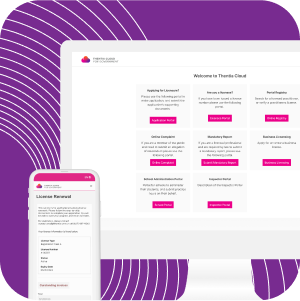Around the world, a growing number of regulatory authorities are facing criticism from their customers, the government, and the public. Many of them see regulators as overly bureaucratic, focused on the wrong things, and too slow moving. In response to feedback like this, and its potential to invite greater oversight or lead to consolidation, regulatory bodies are increasingly embracing regulatory transformation. Indeed, more and more regulators are recognizing that regulatory transformation is necessary to make the licensing process more efficient and effective, while enabling them to better protect the public.
At its core, regulatory transformation is about streamlining and modernizing existing approaches to licensing, while also becoming risk-based and data-driven. In practice, that could mean using data to shorten license processing times or to analyze trends. It could also mean using emerging technologies to improve performance, allocating time and resources based on risk, minimizing administrative overhead, or increasing the accuracy, consistency, and completeness of the work they do.
To achieve these and other outcomes, regulatory authorities must first look inwards. In addition to examining their mandated function and all of the legislation, policies, and procedures associated with it, they also have to look at the people, internal processes, and technology they use to do their work. Of course, before they can do that, regulators must understand when regulatory transformation is necessary and whether or not they’re actually ready for it.
How to recognize when regulatory transformation is needed
There can be many different indications that a regulatory body would benefit from transformation. Still relying on inefficient paper-based processes to support the license application and renewal process is one of the most common examples. To be clear, however, even if those processes are already happening online, regulatory transformation may still be necessary if they are powered by a solution that’s custom built, difficult to use, or that doesn’t integrate with other systems.
Another telltale sign that regulatory transformation is needed is an unwavering adherence to decades-old processes, even when they’re no longer fit for purpose. This is particularly true among regulators who have adopted a “this is how we’ve always done it” mentality rather than adapting to the new realities they face. In other cases, being asked to solve problems that fall outside the scope of a regulatory authority’s mandate can also be a sign that transformation is needed. Workforce planning is a good example. Some regulators get tasked with trying to bring more people into a particular profession, even though that isn’t what they are actually there to do.
What actually drives change
While the signs noted above represent just a few examples of when regulatory authorities might be ripe for transformation, for a long time they were easy to overlook because there were virtually no consequences in doing so. In today’s environment, by contrast, where everyone has greater expectations and aren’t shy about expressing them, those kinds of issues can no longer simply be kept on the back burner. Faced with greater scrutiny, many regulators have been put in an uncomfortable position that’s pushing them to take action.
In addition to that discomfort, there are typically two main catalysts that drive regulatory authorities to embrace regulatory transformation. The first is when there’s a changing of the guard. As new talent comes in, it’s only natural to take stock of how things are being done and to identify ways of doing them better. The second big catalyst is when a new, previously unidentified risk lands on the regulator’s radar. If there’s suddenly a security breach, for example, existing processes will most certainly be revisited.
Of course, no matter the reason for pursuing regulatory transformation, the key is having a solid approach to execute that initiative.
How to think about regulatory transformation
For regulatory transformation to happen, regulators must first take a clear and objective look at everything they do, including all of the processes they follow, systems they use, and legacy approaches they take. The idea is to challenge the status quo, evaluate how effective they are at what they do, and make whatever changes are necessary to become more streamlined, productive, and effective at meeting their mandate.
Among the questions that regulators might ask themselves as they think about transformation may include:
- Are we focused on the right things?
- Do we know where the risks to the public lie and, equally important, where they don’t?
- Are our decisions data-driven or assumption-driven?
- Could any of our existing processes be combined or eliminated?
- Are we doing things we aren’t actually mandated to do?
While questions like these are indicative of what regulators should be thinking about, they only scratch the surface of what must be considered. If that reality makes regulatory transformation seem like a daunting prospect, rest assured that it doesn’t have to be.
Introducing the Ascend Institute Regulatory Transformation Framework and the Ascend Institute Regulatory Effectiveness (AIRE) Index
Thentia recently launched the Ascend Institute Regulatory Transformation Framework, a holistic regulatory improvement program featuring a simple self-assessment tool called the Ascend Institute Regulatory Effectiveness (AIRE) Index. The AIRE Index helps regulators calculate their capacity to deliver effective regulatory outcomes. It does this by providing them with a framework for reviewing every aspect of their regulatory activity and then scoring their organization based on its effectiveness.
Regulators who use the AIRE Index will be able to review their organizational capabilities across five critical regulatory functions and seven organizational management functions. They will also be able to examine their digital maturity and determine their capacity to deliver more effective regulatory outcomes through digital technologies and processes. Ultimately, the Index provides a way for regulators to conduct a confidential, repeatable self-assessment within their organization that they can use to help inform strategic and transformation priorities.
As a company built by regulators, we’re excited to provide the AIRE Index as a resource for the regulatory community. We think that you’ll find it to be a very useful resource and one that we hope you’ll come back to again and again. Please also note that any regulatory authority that completes the Index and shares the resulting data with us will receive useful benchmarking data in the coming months. Importantly, data collected will be anonymized and confidential.
Click here to download the Regulatory Transformation Framework and AIRE Index.













